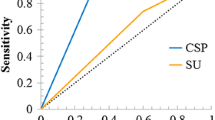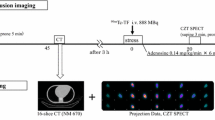Abstract
Background
Limited data address the roles of gender, perfusion defect reversibility, and imaging position in interpretation of images acquired on an upright/supine cadmium-zinc-telluride (CZT) cardiac imaging system.
Methods and Results
From a consecutive cohort of patients imaged on an upright/supine CZT camera, 260 patients with coronary angiograms were studied. Multivariable models identified gender as a significant effect modifier for imaging variables of CAD. For males, a supine summed stress score (SSS) ≥ 3 provided high accuracy (sensitivity 70.7%, specificity 72.2%), and highest contribution to multivariable models. In females, supine SSS ≥ 2 provided the best cut-off for defect size and severity (sensitivity 90%, specificity 35.9%), but specificity was improved substantially to 53.3% with decrease in sensitivity to 80% by also requiring quantitative identification of perfusion defect reversibility in the supine position. Eight variables, accurate for predicting coronary disease, were more accurate with supine than upright imaging.
Conclusions
Perfusion defect reversibility improved specificity in female patients for detection of coronary disease compared to perfusion defect size and extent alone. Supine images provided superior accuracy for detection of coronary disease compared to upright images.




Similar content being viewed by others
Abbreviations
- SPECT:
-
Single-photon emission computerized tomography
- SSS:
-
Summed stress score
- Combined SSS:
-
Combined summed stress score (SSS ≥ 3 both supine and upright, or SSS ≥ 5 in either upright or supine position)
- Supine SSS:
-
Summed stress score in supine position
- SRS:
-
Summed rest score
- SDS:
-
Summed difference score
- SRP:
-
Summed rest percentage
- SSP:
-
Summed stress percentage
- QREV:
-
Total quantitative change in defect reversibility in the entire left ventricle
- QREVS:
-
QREV in the supine position
References
Duvall WL, Sweeny JM, Croft LB, Barghash MH, Kulkarni NK, Guma KA, et al. Comparison of high efficiency CZT SPECT MPI to coronary angiography. J Nucl Cardiol 2011;18:595-604.
Gimelli A, Liga R, Duce V, Kusch A, Clemente A, Marzullo P. Accuracy of myocardial perfusion imaging in detecting multivessel coronary artery disease: A cardiac CZT study. J Nucl Cardiol 2017;24:687-95.
Nakazato R, Tamarappoo BK, Kang X, Wolak A, Kite F, Hayes SW, et al. Quantitative upright-supine high-speed SPECT myocardial perfusion imaging for detection of coronary artery disease: Correlation with invasive coronary angiography. J Nucl Med 2010;51:1724-31.
Betancur J, Hu L-H, Commandeur F, Sharir T, Einstein AJ, Fish MB, et al. Deep learning analysis of upright-supine high-efficiency SPECT myocardial perfusion imaging for prediction of obstructive coronary artery disease: A multicenter study. J Nucl Med 2019;60:664-70.
Perrin M, Djaballah W, Moulin F, Claudin M, Veran N, Imbert L, et al. Stress-first protocol for myocardial perfusion SPECT imaging with semiconductor cameras: High diagnostic performances with significant reduction in patient radiation doses. Eur J Nucl Med Mol Imaging 2015;42:1004-11.
Ben-Haim S, Almukhailed O, Neill J, Slomka P, Allie R, Shiti D. Clinical value of supine and upright myocardial perfusion imaging in obese patients using the D-SPECT camera. J Nucl Cardiol 2014;21:478-85.
Jameria ZA, Abdallah M, Fernandez-Ulloa M, O’Donnell R, Dwivedi AK, Washburn E, et al. Analysis of stress-only imaging, comparing upright and supine CZT camera acquisition to conventional gamma camera images with and without attenuation correction, with coronary angiography as a reference. J Nucl Cardiol 2018;25:540-9.
Diamond GA, Forrester JS. Analysis of probability as an aid in the clinical diagnosis of coronary-artery disease. N Engl J Med 1979;300:1350-8.
Dorbala S, Ananthasubramaniam K, Armstrong IS, Chareonthaitawee P, DePuey EG, Einstein AJ, et al. Single photon emission tomography (SPECT) myocardial perfusion imaging guidelines: Instrumentation, acquisition, processing, and interpretation. J Nucl Cardiol 2018;25:1784-846.
Iskandar A, Limone B, Parker MW, Perugini A, Kim H, Jones C, et al. Gender differences in the diagnostic accuracy of SPECT myocardial perfusion imaging: A bivariate meta-analysis. J Nucl Cardiol 2013;20:53-63.
Gimelli A, Bottai M, Quaranta A, Giorgetti A, Genovesi D, Marzullo P. Gender differences in the evaluation of coronary artery disease with a cadmium-zinc-telluride camera. Eur J Nucl Med Mol Imaging 2013;40:1542-8.
Acknowledgement
The authors thank Marge Duke for her invaluable assistance with the data management.
Disclosures
None of the above authors have any conflicts of interest.
Author information
Authors and Affiliations
Corresponding author
Additional information
Publisher's Note
Springer Nature remains neutral with regard to jurisdictional claims in published maps and institutional affiliations.
The authors of this article have provided a PowerPoint file, available for download at SpringerLink, which summarizes the contents of the paper and is free for re-use at meetings and presentations. Search for the article DOI on SpringerLink.com.
Funding
Funded by a Grant from the John R. Strauss Fund for Research and Education in Cardiovascular Imaging.
Electronic supplementary material
Below is the link to the electronic supplementary material.
12350_2019_1878_MOESM1_ESM.tif
Supplementary material 1 Supplemental Fig. 1 Receiver operating curves for male model 2 and female model 2 (TIFF 4841 kb)
Rights and permissions
About this article
Cite this article
Athar, M.W., Waqar, F., Dwivedi, A.K. et al. Effects of gender and defect reversibility on detection of coronary disease with an upright and supine cadmium-zinc-telluride camera. J. Nucl. Cardiol. 28, 1569–1582 (2021). https://doi.org/10.1007/s12350-019-01878-7
Received:
Accepted:
Published:
Issue Date:
DOI: https://doi.org/10.1007/s12350-019-01878-7




